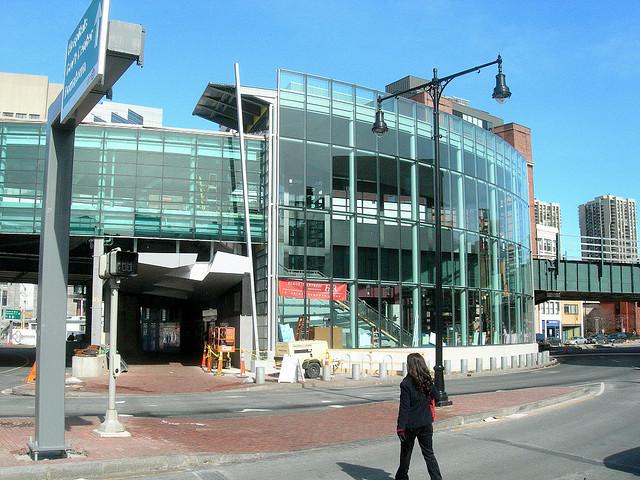Written by A.P. Blake
BOWDOIN STATION, last stop on the Blue Line inbound – only if you’re riding on a weekday between 5:15 a.m. and 6:30 p.m., that is, and if you catch it before the proposed Blue Line extension to the Red Line at Charles/MGH Station: a project dubbed “the Red-Blue Connector.” I believe this extension should be placed as a priority to the MBTA’s other service extension proposals.
The Red-Blue Connector, which would connect the only two rapid transit lines in the MBTA which do not meet, is a project which the MBTA is legally mandated to complete as environmental mitigation to the infamous Big Dig. However, such a project does come at a cost, and that cost is Bowdoin Station.
Bowdoin Station is located in Bowdoin Square, where Cambridge, Bowdoin, and New Sudbury Streets meet, about 1,000 feet from Government Center, and just a 950-foot walk from the Sawyer Business School – making it the shortest walk to the building from any other station entrance in the system. The proposed connector would make a connection to the Red Line at Charles/MGH, about 2,000 feet to the west. Every day, passengers try to find a way to bridge this 2,000-foot gap.
An estimated 10,000 passengers per day who would use the connector are currently using the Orange and Green lines to get between the Red and Blue lines. This puts a great deal of stress on the system between the four downtown transfer stations, and reduces capacity overall, especially in these choking points. On top of this, there are a few dedicated passengers who actually make the trek to Charles/MGH Station and Massachusetts General Hospital from Bowdoin on foot every commute. For those with a monthly pass, making the connection by foot merely means lost calories, but for anyone else, it certainly means lost dollars. In addition to the convenience and increased system capacity, the Red-Blue Connector is expected to convert 1,500 vehicle trips to transit trips, reducing auto emissions in the region.
The expected reduction of emissions resulting from the Red-Blue Connector is the reason for this project, and other MBTA projects, being legally mandated in turn for Big Dig funds. After the MBTA sat on the project for more than a decade, a court ruling in 2006 finally forced the MBTA to begin the planning process for the project. Since 2007, numerous studies have been under way to determine the best method to lay out the new tracks. Today there are three primary alternatives on the table; those alternatives are “No Build,” “Alternative 1,” and “Alternative 2.”
“No Build” involves utilization of all existing infrastructure, including about 500 feet of tail tracks west of Bowdoin Station. The new tunnel would begin where these tail tracks leave off, and then proceed under Cambridge Street to Charles/MGH Station. Although Bowdoin would be preserved for now under such an alternative, the sharp curves following Bowdoin create a great deal of wear on the trains – and that means more maintenance and higher long-term costs. It should also be noted that currently only four of each trains’ six cars can pick up passengers on the eastbound platform, which certainly carries concerns related to future operations.
Alternative 1 is the preferred alternative by the Massachusetts Executive Office of Transportation (Mass EOT) and would mean the complete closure and demolition of Bowdoin Station, with no plans for replacement or relocation. Although the station does face low ridership, much of this may be contributed to its limited hours, poor location, and close proximity to Government Center Station. Alternative 1 would actually be a very poor choice, and means less service for those in or commuting to the West End, Beacon Hill, Government Center, and our very own Suffolk University.
Alternative 2, although more likely than “No Build,” still faces a stiff arm from the Mass EOT. This alternative calls for the relocation of Bowdoin Station, approximately 500 feet west of the current station, and at the center point between Government Center and Charles/MGH stations. Considering the walking distance between the two aforementioned stations is 3,000 feet – compared to 2,300 feet from Government Center to State Street to Aquarium – the station is clearly justified and well needed.
The residents, businesses, and commuters of the area would directly benefit from this placement – which lands roughly between Staniford, Temple and Hancock streets – even more so than the current location. The service to the Suffolk CAS campus would undoubtedly improve while still being the closest station to the Sawyer Business School, albeit then equaled by Government Center. At nearly any given time during Bowdoin’s operations, one is likely to find a Suffolk student exiting or waiting for a train. Bowdoin is a gem to the area, and should certainly not be lost, especially without the great support it surely deserves. The Red-Blue Connector is a project which must go forward, but not at the expense of our station.
Alternative 2 is the best option, and in the event that it passes, the current Bowdoin Station should remain as a place for storing Blue Line trains overnight or for taking disabled trains off the line. Alternative 1 is detrimental to the system and the neighborhood, with the elimination of already existing infrastructure which I find to still be useful as the system changes shape. I find that Alternative 2 would best satisfy the needs of the city as well as the MBTA’s commuters.







